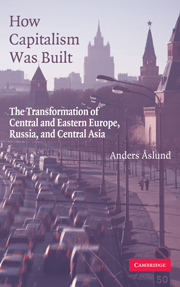Book contents
- Frontmatter
- Contents
- List of Tables and Figures
- List of Abbreviations
- Acknowledgments
- Introduction: A World Transformed
- 1 Communism and Its Demise
- 2 Shock Therapy versus Gradualism
- 3 Output: Slump and Recovery
- 4 Liberalization: The Creation of a Market Economy
- 5 From Hyperinflation to Financial Stability
- 6 Privatization: The Establishment of Private Property Rights
- 7 An Inefficient Social System
- 8 Democracy versus Authoritarianism
- 9 From Crime toward Law
- 10 The Role of Oligarchs
- 11 The Impact of the Outside World
- Conclusions: A World Transformed
- Bibliography
- Index
11 - The Impact of the Outside World
Published online by Cambridge University Press: 05 September 2012
- Frontmatter
- Contents
- List of Tables and Figures
- List of Abbreviations
- Acknowledgments
- Introduction: A World Transformed
- 1 Communism and Its Demise
- 2 Shock Therapy versus Gradualism
- 3 Output: Slump and Recovery
- 4 Liberalization: The Creation of a Market Economy
- 5 From Hyperinflation to Financial Stability
- 6 Privatization: The Establishment of Private Property Rights
- 7 An Inefficient Social System
- 8 Democracy versus Authoritarianism
- 9 From Crime toward Law
- 10 The Role of Oligarchs
- 11 The Impact of the Outside World
- Conclusions: A World Transformed
- Bibliography
- Index
Summary
The collapse of communism and the Soviet bloc dominated public discussion all over the world in 1989. Among the questions raised were the following: What relation would the postcommunist countries have to the West? What assistance did they need? What could and should the West do for them? Which organizations should be used? How much financing was needed, and was the West ready?
The West's desire for the postcommunist countries' success as democracies and market economies is often taken for granted, but Western opinion was divided. A broad Western opinion favored democracy and market economies, even though most protagonists were tacitly doubtful about the prospects for democracy in the former Soviet Union. The West saw little threat from the former Soviet Union but also little gain. An important countercurrent argued that Russia was a patent menace best kept down and out. There was no consensus about what the West could or should do. In effect, the West as a whole adopted Central Europe, and Scandinavia adopted the Baltics. Southeast Europe was left in a limbo, and Russia with the rest of the CIS were left out in the cold.
Most opposed large-scale Western financial support for the postcommunist East for a variety of reasons. At this time, development aid to the Third World was approaching a nadir, because it had been widely discredited as corrupting rather than helping.
- Type
- Chapter
- Information
- How Capitalism Was BuiltThe Transformation of Central and Eastern Europe, Russia, and Central Asia, pp. 281 - 304Publisher: Cambridge University PressPrint publication year: 2007
- 1
- Cited by



